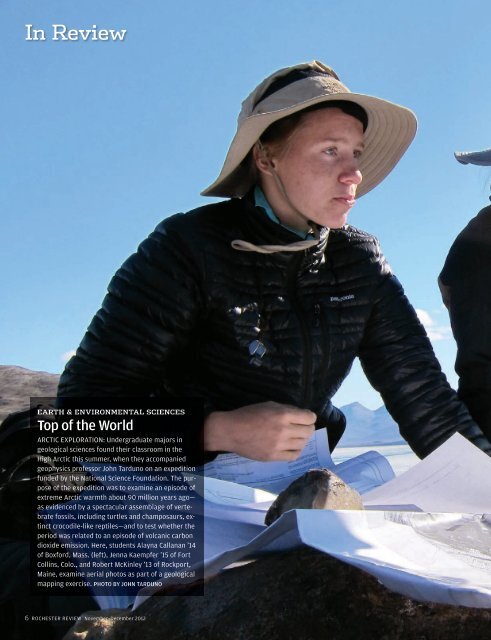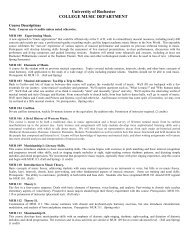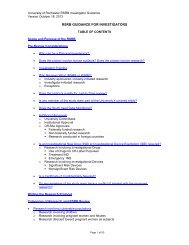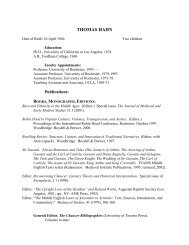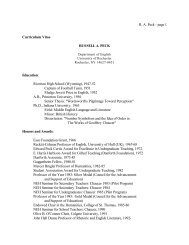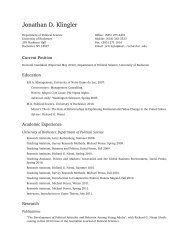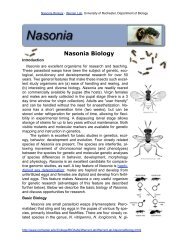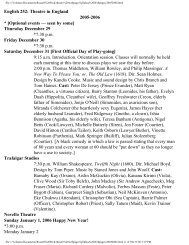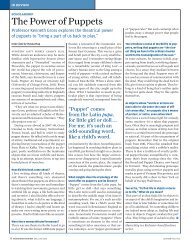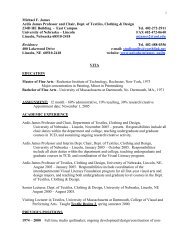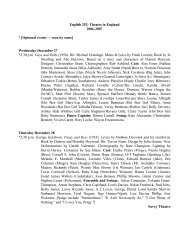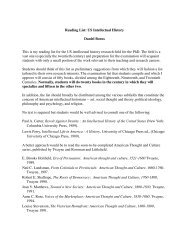In Review - University of Rochester
In Review - University of Rochester
In Review - University of Rochester
Create successful ePaper yourself
Turn your PDF publications into a flip-book with our unique Google optimized e-Paper software.
<strong>In</strong> <strong>Review</strong><br />
Earth & EnvironmEntal SciEncES<br />
Top <strong>of</strong> the World<br />
ARCTIC EXPLORATION: Undergraduate majors in<br />
geological sciences found their classroom in the<br />
High Arctic this summer, when they accompanied<br />
geophysics pr<strong>of</strong>essor John Tarduno on an expedition<br />
funded by the National Science Foundation. The purpose<br />
<strong>of</strong> the expedition was to examine an episode <strong>of</strong><br />
extreme Arctic warmth about 90 million years ago—<br />
as evidenced by a spectacular assemblage <strong>of</strong> vertebrate<br />
fossils, including turtles and champosaurs, extinct<br />
crocodile-like reptiles—and to test whether the<br />
period was related to an episode <strong>of</strong> volcanic carbon<br />
dioxide emission. Here, students Alayna Callanan ’14<br />
<strong>of</strong> Boxford, Mass. (left), Jenna Kaempfer ’15 <strong>of</strong> Fort<br />
Collins, Colo., and Robert McKinley ’13 <strong>of</strong> Rockport,<br />
Maine, examine aerial photos as part <strong>of</strong> a geological<br />
mapping exercise. PhoTo by John Tarduno<br />
6 ROCHESTER REVIEW November–December 2012
November–December 2012 ROCHESTER REVIEW 7
Fringe Festival<br />
High-Flying Debut<br />
AERIAL DANCE: For five days in September, <strong>Rochester</strong>’s performing and<br />
visual arts scene took on a new facet, with the launch <strong>of</strong> the first First<br />
Niagara <strong>Rochester</strong> Fringe Festival. With almost 200 performances—including<br />
an excerpt <strong>of</strong> “Bound(less),” a large-scale, vertical dance performance by<br />
the group Bandaloop—the festival drew an audience <strong>of</strong> more than 33,000.<br />
Theater producer Erica Fee ’98 returned from London to lead the effort<br />
to create a fringe festival in <strong>Rochester</strong>, and the <strong>University</strong> sponsored and<br />
supported about 30 shows. PHoto by ADAm Fenster<br />
8 ROCHESTER REVIEW November–December 2012
November–December 2012 ROCHESTER REVIEW 9
Student Life<br />
Star Struck<br />
KOREA BOUND: Brian Shin ’15 <strong>of</strong> Temecula, Calif., is spending part <strong>of</strong> this<br />
fall in Korea, where he’s competing on KPop Star, an American Idol-style<br />
reality television competition. Chosen from a pool <strong>of</strong> nearly 400 people<br />
during auditions in New York City, the international relations and Asian studies<br />
major charmed producers with acoustic guitar renditions <strong>of</strong> Coldplay’s<br />
“Viva La Vida” and Psy’s “Gangnam Style.” After Shin passed the first round<br />
<strong>of</strong> auditions in New York, producers from the show traveled to the <strong>University</strong><br />
to capture a slice <strong>of</strong> Shin’s life on campus. Contestants on KPop Star sing or<br />
dance, hoping to land a coveted contract with one <strong>of</strong> Korea’s three largest<br />
record labels. Photo by AdAm FenSter<br />
10 ROCHESTER REVIEW November–December 2012
November–December 2012 ROCHESTER REVIEW 11
History <strong>of</strong> Medicine<br />
Healthy—and Humorous—Debate<br />
PAGE TURNER: Featuring more than 200 examples <strong>of</strong> editorial cartoons, a<br />
new history <strong>of</strong>fers an entertaining review <strong>of</strong> 100 years <strong>of</strong> <strong>of</strong>ten rancorous<br />
wrangling over health care reform. “Unlike the pain involved in our political<br />
struggle, cartoons deliver their uncomfortable truths with such irreverent<br />
wit and visual imagination that you can’t help but chuckle,” says Theodore<br />
Brown, a historian <strong>of</strong> medicine, public health, and health policy at <strong>Rochester</strong>.<br />
He is one <strong>of</strong> four authors <strong>of</strong> The Quest for Health Care Reform: A Satirical<br />
History, published in October by the American Public Health Association.<br />
PHoto by ADAm Fenster<br />
12 ROCHESTER REVIEW November–December 2012
November–December 2012 ROCHESTER REVIEW 13
<strong>In</strong> RevIew<br />
Brain and Cognitive SCienCeS<br />
Anticipation . . . Is Keeping Me Waiting<br />
taking a new look at a famous study, rochester researchers suggest that a reliable<br />
environment is at least as important as self-control when it comes to delaying gratification.<br />
By Susan Hagen<br />
<strong>In</strong> the late 1960s, psychologist Walter<br />
Mischel and other researchers at Stanford<br />
famously showed that individual differences<br />
among preschool-age children in<br />
the ability to delay gratification correlated<br />
strongly with success in later life. Longer<br />
wait times as a child were linked years later<br />
to higher SAT scores, less substance abuse,<br />
and parental reports <strong>of</strong> better social skills.<br />
Because <strong>of</strong> the surprising correlation,<br />
the landmark “marshmallow studies”—<br />
children were presented with the choice<br />
<strong>of</strong> eating one marshmallow immediately or<br />
holding out for two later—have been cited<br />
as evidence that qualities such as self-control<br />
or emotional intelligence may be more<br />
important to navigating life successfully<br />
than more traditional measures <strong>of</strong> intelligence,<br />
such as IQ.<br />
u SO TEMPTING: Four-year-old Evelyn Rose<br />
<strong>of</strong> Brighton, N.Y., reenacts an experiment<br />
in a new <strong>Rochester</strong> study indicating that<br />
children’s ability to delay gratification is<br />
influenced as much by their environment<br />
as it is by their innate ability to wait. The<br />
finding significantly revises conclusions <strong>of</strong> a<br />
landmark study from the 1960s.<br />
14 ROCHESTER REVIEW November–December 2012<br />
Now a new <strong>Rochester</strong> study indicates that<br />
being able to delay gratification is influenced<br />
as much by the environment as by innate<br />
ability. Children who experienced reliable<br />
interactions immediately before the marshmallow<br />
task waited on average four times<br />
longer—12 versus 3 minutes—than youngsters<br />
in similar but unreliable situations.<br />
“Our results definitely temper the popular<br />
perception that marshmallow-like tasks<br />
are very powerful diagnostics for self-control<br />
capacity,” says Celeste Kidd, a doctoral<br />
candidate in brain and cognitive sciences<br />
and lead author <strong>of</strong> the study published online<br />
in the journal Cognition.<br />
“Being able to delay gratification—in this<br />
case to wait 15 difficult minutes to earn a<br />
second marshmallow—not only reflects a<br />
child’s capacity for self-control, it also reflects<br />
their belief about the practicality <strong>of</strong><br />
waiting,” says Kidd. “Delaying gratification<br />
is only the rational choice if the child believes<br />
a second marshmallow is likely to be<br />
delivered after a reasonably short delay.”<br />
The findings provide an important reminder<br />
about the complexity <strong>of</strong> human behavior,<br />
adds coauthor Richard Aslin, the<br />
William R. Kenan Pr<strong>of</strong>essor <strong>of</strong> Brain and<br />
Cognitive Sciences. “This study is an example<br />
<strong>of</strong> both nature and nurture playing<br />
a role,” he says. “We know that to some extent,<br />
temperament is clearly inherited because<br />
infants differ in their behaviors from<br />
birth. But this experiment provides robust<br />
evidence that young children’s actions are<br />
also based on rational decisions about their<br />
environment.”<br />
<strong>In</strong> his original experiment, Mischel set<br />
out to understand why some people can<br />
postpone gratification while others give in.<br />
As he continued to track the children in the<br />
1980s, he found that the preschoolers who<br />
waited to earn a second treat seemed to be<br />
more socially competent and to achieve<br />
more scholastically, with average SAT<br />
scores more than 200 points higher. “Based<br />
on these findings,” Kidd and Aslin write in<br />
their paper, “the marshmallow task was argued<br />
to be a powerful diagnostic tool for<br />
predicting personal well-being and later<br />
life achievement”—a yardstick by which to<br />
measure self-control as an enduring and inherent<br />
personal trait.<br />
For the new study, the <strong>Rochester</strong> team<br />
wanted to explore more closely whether<br />
the social environment <strong>of</strong> preschoolers<br />
influences why some are able to resist<br />
the marshmallow while others succumb to<br />
licking, nibbling, and eventually swallowing<br />
the sugary treat. The researchers assigned<br />
ADAm FeNster
28 three- to five-year-olds to two contrasting<br />
environments: unreliable and reliable.<br />
The study results were so strong that a larger<br />
sample group wasn’t required to ensure<br />
statistical accuracy. <strong>In</strong> both groups the children<br />
were given a “create-your-own-cup”<br />
kit and asked to decorate a blank paper that<br />
would be inserted into a cup.<br />
<strong>In</strong> the unreliable condition, the children<br />
were provided a container <strong>of</strong> used crayons<br />
and told that if they could wait, the researcher<br />
would return shortly with a bigger<br />
and better set <strong>of</strong> new art supplies for their<br />
project. After two-and-a-half minutes, the<br />
researcher returned, apologizing that there<br />
were no other art supplies after all.<br />
Next a quarter-inch sticker was placed<br />
on the table, and the children were told that<br />
if they could wait, the researcher would return<br />
with a large selection <strong>of</strong> better stickers<br />
to use. After the same wait, the researcher<br />
again returned empty handed.<br />
The reliable group experienced the same<br />
set up, but the researcher returned with the<br />
promised materials: first with a rotating<br />
tray full <strong>of</strong> art supplies and the next time<br />
with five to seven large stickers.<br />
The marshmallow task followed, with<br />
the explanation that the child could have<br />
“one marshmallow right now. Or—if you<br />
can wait for me to get more marshmallows<br />
from the other room—you can have<br />
two marshmallows to eat instead.” The<br />
researcher removed the art supplies and<br />
placed a single marshmallow in a small dessert<br />
dish directly in front <strong>of</strong> the child.<br />
Kids danced in their seats, sang, and took<br />
pretend naps. Several took a bite from the<br />
bottom <strong>of</strong> the marshmallow then placed<br />
it back in the dessert cup so it looked<br />
untouched.<br />
“We had one little boy who grabbed the<br />
marshmallow immediately, and we thought<br />
he was going to eat it,” recalls Kidd. But he<br />
sat on it. “<strong>In</strong>stead <strong>of</strong> covering his eyes, he<br />
covered the marshmallow.”<br />
Children who experienced unreliable<br />
interactions with an experimenter waited<br />
for a mean time <strong>of</strong> three minutes and two<br />
seconds on the marshmallow task, while<br />
youngsters who experienced reliable interactions<br />
held out for 12 minutes and 2<br />
“Being able to delay gratification—in this case<br />
to wait 15 difficult minutes to earn a second<br />
marshmallow—not only reflects a child’s<br />
capacity for self-control, it also reflects their<br />
belief about the practicality <strong>of</strong> waiting.”<br />
—Celeste Kidd, doctoral candidate in brain<br />
and cognitive sciences<br />
<strong>In</strong> RevIew<br />
seconds. Only one <strong>of</strong> the 14 children in the<br />
unreliable group waited the full 15 minutes,<br />
compared to nine children in the reliable<br />
condition.<br />
“I was astounded that the effect was so<br />
large,” says Aslin. “I thought that we might<br />
get a difference <strong>of</strong> maybe a minute or so.<br />
You don’t see effects like this very <strong>of</strong>ten.”<br />
<strong>In</strong> prior research, children’s wait time<br />
averaged between 5.71 and 6.08 minutes,<br />
the authors report. By comparison, manipulating<br />
the environment doubled wait<br />
times in the reliable condition and halved<br />
the time in the unreliable scenario.<br />
The robust environmental effect provides<br />
strong evidence that the wait times reflect<br />
the children’s rational decision making<br />
about the probability <strong>of</strong> reward, the authors<br />
conclude. The results are consistent with<br />
other research showing that children are<br />
sensitive to uncertainty in future rewards.<br />
So does that mean that if little ones gobble<br />
up dessert without waiting, parents<br />
should worry that they have failed to be<br />
role models <strong>of</strong> reliability?<br />
“Children do monitor the behavior <strong>of</strong> parents<br />
and adults, but it’s unlikely that they’re<br />
keeping detailed records <strong>of</strong> every single action,”<br />
says Aslin. “It’s the overall sense <strong>of</strong> a<br />
parent’s reliability or unreliability that’s going<br />
to get through, not every single action.”<br />
Adds Kidd: “Don’t do the marshmallow<br />
test on your kitchen table and conclude<br />
something about your child. It especially<br />
would not work with a parent, because<br />
your child has all sorts <strong>of</strong> strong expectations<br />
about what a person who loves them<br />
very much is likely to do.”r<br />
November–December 2012 ROCHESTER REVIEW 15
Learn<br />
What Is Adaptive Optics?<br />
Developed by astronomers to take clear pictures <strong>of</strong> the sky<br />
without distortion from the Earth’s atmosphere, the process<br />
<strong>of</strong> adaptive optics has been used by David Williams and his<br />
collaborators to obtain very sharp images from inside the<br />
eye, as well as to form images on the retina sharper than<br />
those obtained by more traditional visual correction.<br />
6 Deformable<br />
Deformable surface<br />
Actuators<br />
Mirror<br />
A thin, deformable<br />
surface that can<br />
be shaped by<br />
actuators attached<br />
to its back. The<br />
mirror is reshaped<br />
until it compensates<br />
for the flaws<br />
in the aberrated<br />
wavefront.<br />
5<br />
4 Wavefront<br />
Sensor<br />
Measures the<br />
eye’s aberrations.<br />
16 rocHester revIeW november–December 2012<br />
Control System<br />
Controls the shape <strong>of</strong><br />
the deformable mirror<br />
based on the measured<br />
aberrations.<br />
Lenslet<br />
array<br />
2<br />
Aberrated Wavefront<br />
Light reflected from the<br />
retina is aberrated, or<br />
blurred, because <strong>of</strong> optical<br />
imperfections in the eye.<br />
7 Corrected<br />
Lens<br />
Cornea<br />
Wavefront<br />
The wavefront<br />
reflected from the<br />
deformable mirror<br />
has been flattened,<br />
which removes<br />
aberrations in the<br />
cornea and lens.<br />
1<br />
Human Eye<br />
The retina in the back<br />
<strong>of</strong> the human eye<br />
contains hundreds<br />
<strong>of</strong> millions <strong>of</strong> cells<br />
invisible to commercial<br />
cameras designed<br />
to capture images<br />
<strong>of</strong> the retina.<br />
3 Beamsplitter<br />
Optical device splits the beam<br />
<strong>of</strong> light in two, sending part to<br />
the wavefront sensor and part<br />
to the imaging sensor.<br />
8<br />
Retina<br />
Image Sensor<br />
The corrected wavefront is<br />
focused here, capturing a high<br />
resolution image <strong>of</strong> the retina.<br />
IllustratIon by steve boerner for RochesteR <strong>Review</strong> (source: DavID WIllIams, WIllIam G. allyn Pr<strong>of</strong>essor <strong>of</strong> meDIcal oPtIcs)
Sharpest Pictures Ever <strong>of</strong> the Retina<br />
The images below show the advantage that adaptive<br />
optics retinal imaging <strong>of</strong>fers over standard commercial<br />
cameras for imaging the retina.<br />
Retinal image taken with adaptive optics—the first<br />
ever <strong>of</strong> its kind—showing the three kinds <strong>of</strong> cones<br />
responsible for color vision. Each cone is five<br />
microns in diameter, about 1/20th the diameter<br />
<strong>of</strong> a human hair.<br />
The clearest image ever taken <strong>of</strong> rod photoreceptors<br />
in the living human eye. The rods, each just<br />
two microns in size, are the smaller spots in<br />
the image.<br />
ISTOCkpHOTO (TOp); AuST<strong>In</strong> ROORDA (CEnTER); Alf DubRA (bOTTOm)<br />
Image <strong>of</strong> a<br />
human retina<br />
taken with<br />
a standard<br />
commercial<br />
camera.<br />
Vision science<br />
Stars in Your Eyes<br />
One <strong>of</strong> the world’s leading<br />
experts on human vision, David<br />
Williams—the William G. Allyn<br />
Pr<strong>of</strong>essor <strong>of</strong> Medical Optics—has<br />
pioneered new technologies<br />
that are improving eyesight for<br />
people who are legally blind and<br />
those with 20/20 vision alike.<br />
And he’s done it by applying<br />
methods <strong>of</strong> astronomers to the<br />
terrain <strong>of</strong> the eye.<br />
<strong>In</strong> September, Williams<br />
received the António<br />
Champalimaud Vision Award in<br />
Lisbon, Portugal, in recognition<br />
<strong>of</strong> his work on adaptive optics. <strong>In</strong><br />
awarding the prize, the jury said<br />
that Williams and his research<br />
group have “set the stage for<br />
current approaches to vision correction<br />
and have opened up new<br />
possibilities for imaging retinal<br />
structures in the living eye.”<br />
With a prize <strong>of</strong> 1 million euros,<br />
the award recognizes contributions<br />
to vision research and is<br />
the largest in vision science and<br />
ophthalmology. Williams receives<br />
half the prize, which will support<br />
his future research; he shares the<br />
award with developers <strong>of</strong> optical<br />
coherence tomography, another<br />
method <strong>of</strong> imaging the retina<br />
that has improved the diagnosis<br />
and clinical management <strong>of</strong><br />
retinal disease.<br />
Williams says that “this<br />
technology makes it possible<br />
for us to image the retina with<br />
unsurpassed resolution and<br />
moves us further down the path<br />
to the understanding <strong>of</strong> retinal<br />
disease.”<br />
Adaptive optics was first<br />
developed by astronomers so<br />
that telescopes could see more<br />
clearly through the Earth’s atmosphere.<br />
The technologies that<br />
Williams and his group developed<br />
apply these techniques to the<br />
eye, making it possible to image<br />
individual retinal cells—down to<br />
individual photoreceptors in the<br />
living human retina—by looking<br />
through the pupil. The group<br />
BrANDON VICk<br />
developed techniques that not<br />
only can modify the light leaving<br />
the eye to obtain better pictures<br />
<strong>of</strong> the retina but also can modify<br />
the light going into the eye<br />
to achieve better vision. The<br />
methods that Williams’s team developed<br />
are used throughout the<br />
world in Lasik procedures today.<br />
Williams, whose primary appointment<br />
is in the <strong>In</strong>stitute <strong>of</strong><br />
Optics, is dean for research in<br />
Arts, Sciences & Engineering. He<br />
joined the faculty in 1981 and<br />
is also director <strong>of</strong> the Center<br />
for Visual Science, a research<br />
David Williams<br />
program bringing together<br />
30 faculty members from five<br />
departments to understand how<br />
we see and the disorders that<br />
compromise sight.<br />
While Williams has led the<br />
way, he notes that the effort<br />
was by no means his alone. He<br />
calls the discoveries in adaptive<br />
optics that the Champalimaud<br />
Award honors the “work <strong>of</strong> many<br />
graduate students, postdoctoral<br />
fellows, and colleagues over two<br />
decades.<br />
“It is great for our whole community<br />
that the achievements<br />
and potential <strong>of</strong> adaptive optics<br />
for vision are showcased with<br />
this award.”<br />
—Leonor Sierra<br />
November–December 2012 ROCHESTER REVIEW 17
Discover<br />
Geneticists Verify Cholesterol-Cancer Link<br />
Could cholesterol-lowering<br />
drugs be part <strong>of</strong> the future<br />
battle against cancer?<br />
<strong>Rochester</strong> scientists are adding<br />
new genetic evidence to a longdebated<br />
medical question. in a<br />
new study, Hartmut (Hucky)<br />
Land, the Robert and Dorothy<br />
Markin Pr<strong>of</strong>essor and chair <strong>of</strong><br />
the Department <strong>of</strong> Biomedical<br />
Genetics, and coauthor Bradley<br />
Smith, a postdoctoral fellow in<br />
Land’s lab, found that defective<br />
18 ROCHESTER REVIEW November–December 2012<br />
cholesterol exportation from<br />
cells appears to be a key component<br />
in a variety <strong>of</strong> cancers.<br />
Published in the online<br />
journal Cell Reports, the<br />
data support several recent<br />
population-based studies that<br />
suggest people who take cholesterol-lowering<br />
drugs may have<br />
a reduced risk <strong>of</strong> cancer and,<br />
conversely, that people with<br />
the highest levels <strong>of</strong> cholesterol<br />
seem to have an elevated risk <strong>of</strong><br />
cancer. the cancer-cholesterol<br />
question has been debated<br />
since the early 20th century.<br />
But until now, genetic evidence<br />
directly linking cholesterol and<br />
malignancy has been lacking,<br />
says Land, who is scientific<br />
director <strong>of</strong> the Wilmot Cancer<br />
Center. Millions <strong>of</strong> americans<br />
take cholesterol-lowering<br />
drugs or statins, as prescribed<br />
by physicians. Clinical trials also<br />
are evaluating statins as a tool<br />
against cancer, and some previous<br />
studies suggest that when<br />
used in combination with chemotherapy,<br />
statins might make<br />
chemotherapy more effective<br />
by sensitizing certain cancer<br />
cells to chemotherapy-induced<br />
cell death. Land, however, urges<br />
caution and further study. “the<br />
link between cholesterol and<br />
cancer is clear,” he says, “but<br />
it’s premature to say that statins<br />
are the answer.” —Leslie Orr<br />
TO THE RESCUE: Bacteria have consumed more than 200,000 tons <strong>of</strong> oil and gas in the Gulf <strong>of</strong> Mexico from the Deepwater Horizon spill.<br />
Bacterial Clean-Up Crew Attacks Oil Spill<br />
Naturally occurring bacteria in<br />
the Gulf <strong>of</strong> Mexico consumed and<br />
removed at least 200,000 tons <strong>of</strong><br />
oil and natural gas that spewed<br />
into the gulf following the disastrous<br />
2010 Deepwater Horizon<br />
explosion and oil spill.<br />
that’s according to a study<br />
by <strong>Rochester</strong> scientist John<br />
Kessler, associate pr<strong>of</strong>essor<br />
in the Department <strong>of</strong> earth<br />
and environmental Sciences,<br />
and a researcher at texas a&M<br />
<strong>University</strong>. the pair analyzed an<br />
extensive data set to determine<br />
not only how much oil and gas<br />
was eaten by bacteria, but also<br />
how the characteristics <strong>of</strong> the<br />
feast changed with time.<br />
Published in Environmental<br />
Science and Technology, the<br />
results include the first measurements<br />
<strong>of</strong> how the rate at<br />
which the bacteria ate the oil<br />
and gas changed as the disaster<br />
progressed, information that’s<br />
fundamental to understanding<br />
the spill and predicting the<br />
behavior <strong>of</strong> future spills.<br />
“a significant amount <strong>of</strong> the oil<br />
and gas that was released was<br />
retained within the ocean water<br />
more than one-half mile below<br />
the sea surface. it appears that<br />
the hydrocarbon-eating bacteria<br />
did a good job <strong>of</strong> removing the<br />
majority <strong>of</strong> the material that was<br />
retained in these layers,” says<br />
Kessler, coauthor <strong>of</strong> the study.<br />
—Leonor Sierra<br />
UNiteD StateS Navy
Protein Helps DNA Repair in Aging Cells<br />
scientists have long wondered<br />
why cells lose their ability to repair<br />
themselves as they age. Now<br />
research by <strong>Rochester</strong> scientists<br />
has uncovered two intriguing<br />
clues. DNa strands in human<br />
cells routinely break and repair<br />
themselves, but as cells age,<br />
the repair system becomes less<br />
A Brain-Cleansing Discovery<br />
a previously unrecognized<br />
system that drains waste from<br />
the brain has been discovered<br />
by neuroscientists at the Medical<br />
center. the highly organized<br />
system acts like a series <strong>of</strong> pipes<br />
that piggyback on the brain’s<br />
blood vessels, sort <strong>of</strong> a shadow<br />
plumbing system that seems to<br />
serve much the same function<br />
in the brain as the lymph system<br />
does in the rest <strong>of</strong> the body—to<br />
drain away waste products.<br />
“Waste clearance is <strong>of</strong> central<br />
importance to every organ,<br />
and there have been longstanding<br />
questions about how<br />
the brain gets rid <strong>of</strong> its waste,”<br />
says Maiken Nedergaard,<br />
the Frank P. smith Pr<strong>of</strong>essor<br />
<strong>of</strong> Neurosurgery and senior<br />
author <strong>of</strong> the research, which<br />
was published online in Science<br />
Translational Medicine. “this<br />
work shows that the brain is<br />
cleansing itself in a more organized<br />
way and on a much larger<br />
Photo ReseaRcheRs<br />
efficient, and flaws in the process<br />
lead to a decline in functionality<br />
and an increase in the incidence<br />
<strong>of</strong> tumors. to find out whether<br />
the process could be slowed or<br />
even reversed, biologists Andrei<br />
Seluanov, Vera Gorbunova, and<br />
colleagues found that the decline<br />
coincided with a global reduction<br />
scale than has been realized<br />
previously.<br />
“We’re hopeful that these findings<br />
have implications for many<br />
conditions that involve the brain,<br />
such as traumatic brain injury,<br />
alzheimer’s disease, stroke, and<br />
Parkinson’s disease,” she adds.<br />
Nedergaard’s team has dubbed<br />
the new system “the glymphatic<br />
system,” since it acts much like<br />
the lymphatic system but is<br />
managed by brain cells known as<br />
glial cells.<br />
scientists have known that<br />
cerebrospinal fluid plays an<br />
important role in cleansing brain<br />
tissue, carrying away waste<br />
products and carrying nutrients<br />
to brain tissue through a process<br />
known as diffusion. the newly<br />
discovered system circulates the<br />
fluid to every corner <strong>of</strong> the brain<br />
much more efficiently.<br />
“It’s as if the brain has two<br />
garbage haulers—a slow one<br />
that we’ve known about, and a<br />
fast one that we’ve just met,”<br />
says Nedergaard. “Given the high<br />
rate <strong>of</strong> metabolism in the brain,<br />
and its exquisite sensitivity,<br />
it’s not surprising that its<br />
mechanisms to rid itself <strong>of</strong><br />
waste are more specialized<br />
and extensive than previously<br />
realized.” —tom Rickey<br />
CLEANING UP: A newly recognized system in<br />
the brain seems to drain waste away much<br />
as the lymphatic system does for the body.<br />
in the levels <strong>of</strong> proteins involved<br />
in the repair process. the group<br />
tried to reverse the age-related<br />
decline by restoring the proteins<br />
to their original levels and found<br />
that only one protein, called<br />
sIRt6, proved effective. the<br />
work has been published in the<br />
Proceedings <strong>of</strong> the National<br />
Academy <strong>of</strong> Sciences. the team<br />
plans to study factors regulating<br />
sIRt6. seluanov says that multiple<br />
groups are trying to develop<br />
drugs that activate the protein,<br />
and he hopes the research will<br />
lead to therapies that help extend<br />
lifespans and treat cancer.<br />
—Peter Iglinski<br />
ARRESTING: Researchers have found a location in a gene <strong>of</strong> the flu<br />
virus that could be a “switch” to turn <strong>of</strong>f its ability to spread.<br />
Is There an ‘Off Switch’ for the Flu?<br />
<strong>Rochester</strong> scientists have helped<br />
identify a location in a gene <strong>of</strong><br />
the influenza a virus that could<br />
be used as a “switch” to disrupt<br />
the replication <strong>of</strong> the virus. If a<br />
way can be found to manipulate<br />
the switch in an organism, the<br />
researchers say it could have important<br />
implications for stopping<br />
the spread <strong>of</strong> the flu. conducted<br />
by Douglas Turner, pr<strong>of</strong>essor<br />
<strong>of</strong> chemistry, and colleagues<br />
Walter Moss, Lumbini Dela-<br />
Moss, and Salvatore Priore at<br />
<strong>Rochester</strong>, and chemists Ryszard<br />
Kierzek and elzbieta Kierzek at<br />
the Polish academy <strong>of</strong> sciences<br />
in Poznan, the work singled out<br />
messenger RNa, which is key to<br />
the production <strong>of</strong> two proteins<br />
the virus needs to propagate. to<br />
produce the second protein, the<br />
messenger RNa has to undergo<br />
the process <strong>of</strong> splicing, in which<br />
two remote sites <strong>of</strong> the long molecule<br />
join together, while the intervening<br />
segment is discarded.<br />
“We look at one <strong>of</strong> the splicing<br />
sites as a potential switch,” says<br />
turner. “If we can inactivate the<br />
switch to prevent the two sites<br />
from coming together, we can<br />
stop the virus from spreading.”<br />
the research was published in<br />
the journal PLoS ONE.<br />
—Peter Iglinski<br />
November–December 2012 ROCHESTER REVIEW 19
MeMorial art Gallery<br />
A Hundred Years<br />
and Counting<br />
The Memorial Art Gallery<br />
celebrates its centennial.<br />
<strong>In</strong> October 2013, the Memorial Art Gallery<br />
will mark the centenary <strong>of</strong> its founding.<br />
And the gallery is celebrating with<br />
yearlong festivities, culminating in the<br />
opening <strong>of</strong> its new Centennial Sculpture<br />
Park next October. The permanent collection<br />
<strong>of</strong> 12,000 works spans 50 centuries <strong>of</strong><br />
world art. The gallery’s director, Grant Holcomb,<br />
and curators have chosen the “MAG<br />
Top 100”—a hundred works <strong>of</strong> special note.<br />
Here is a sampling. To see the full list, visit<br />
http://magart.rochester.edu/PRT2070.<br />
1914<br />
Memory<br />
William Ordway Partridge<br />
Emily Sibley Watson, founder <strong>of</strong> the gallery,<br />
selected sculptor William Ordway partridge<br />
to create a memorial for her son, James<br />
George Averell, who died in 1904 <strong>of</strong> typhoid<br />
fever. The figure <strong>of</strong> a robed woman cradling<br />
a funeral urn is sculpted from Carrara<br />
marble; a portrait relief <strong>of</strong> Averell is located<br />
on the base.<br />
ca. 1885<br />
Stained Glass Window<br />
Tiffany Studios<br />
This window was created by<br />
Louis Comfort Tiffany for the<br />
Corn Hill home <strong>of</strong> <strong>Rochester</strong><br />
tycoon William Kimball, owner<br />
<strong>of</strong> the Kimball Tobacco Factory.<br />
The house was demolished in<br />
the mid 20th century, when<br />
<strong>In</strong>terstate 490 was built; Harold<br />
Rand ’34 rescued the window.<br />
1984<br />
Dr. Caligari<br />
Wendell Castle<br />
This sculpture, made from<br />
curly cherry veneer, ebony, and<br />
gold-plated brass, was inspired<br />
by The Cabinet <strong>of</strong> Dr. Caligari,<br />
a silent horror film from 1920.<br />
Based in <strong>Rochester</strong>, Wendell<br />
Castle is a leading figure in<br />
American craft and art furniture.<br />
He has been commissioned<br />
to create a monumental<br />
cast-iron sculpture as an<br />
anchor installation <strong>of</strong> the new<br />
Centennial Sculpture park.<br />
20 ROCHESTER REVIEW November–December 2012 MEMORIAL ART GALLERY (pHOTOS); © WENDELL CASTLE INC. (CASTLE)
1900–1905<br />
Sullivan Street<br />
Everett Shinn<br />
This oil-on-canvas scene <strong>of</strong> a poor, immigrant<br />
neighborhood in Greenwich Village, with<br />
Washington Square park’s trees just visible at the<br />
end <strong>of</strong> the street, is a good example <strong>of</strong> Everett<br />
Shinn’s depiction <strong>of</strong> the bleaker sides <strong>of</strong> urban life.<br />
MEMORIAL ART GALLERY(pHOTOS); © 2012 THE JACOb AND GWENDOLYN LAWRENCE FOuNDATION,<br />
SEATTLE/ARTISTS RIGHTS SOCIETY (ARS), NEW YORk (LAWRENCE)<br />
1948<br />
Summer Street<br />
Scene in Harlem<br />
Jacob Lawrence<br />
<strong>In</strong> the late 1930s<br />
and 1940s, Jacob<br />
Lawrence’s art focused<br />
on African-American<br />
history, including the<br />
Great Migration <strong>of</strong><br />
African Americans from<br />
the South to the North.<br />
Lawrence himself<br />
moved to Harlem at the<br />
age <strong>of</strong> 13, in 1930, and<br />
this lively, modernist<br />
painting—tempera on<br />
gesso panel—shows<br />
among its figures boys<br />
riding a scooter and<br />
crowding around a<br />
shaved ice cart.<br />
ca. 1852<br />
Peeling Onions<br />
Lilly Martin Spencer<br />
When Lilly Martin<br />
Spencer could not find<br />
patrons for her depictions<br />
<strong>of</strong> allegorical and<br />
literary subjects, she<br />
turned to an area more<br />
accepted for a woman<br />
artist: domestic scenes.<br />
<strong>In</strong> this oil-on-canvas<br />
painting, she shows<br />
a cook wiping away<br />
tears with the back <strong>of</strong><br />
her hand—simultaneously<br />
showing female<br />
labor and playing <strong>of</strong>f<br />
sentimental images<br />
<strong>of</strong> women.<br />
November–December 2012 ROCHESTER REVIEW 21
<strong>In</strong> Brief<br />
ON THE JOB: Kathy Rideout, the new dean <strong>of</strong> the School <strong>of</strong> Nursing, checks on Maiya Colon, her patient<br />
in Strong Memorial Hospital’s neonatal intensive care unit, along with parents Maria and Wil Colon.<br />
New Dean for School <strong>of</strong> Nursing<br />
Kathy Rideout ’95W (edD), ’03<br />
(FlW) has become the new<br />
dean for the school <strong>of</strong> Nursing.<br />
Rideout, a pediatric nurse practitioner<br />
at Golisano Children’s<br />
Hospital at strong, has served as<br />
an associate pr<strong>of</strong>essor <strong>of</strong> clinical<br />
nursing and in administrative<br />
roles at the school over the last<br />
26 years. Previously, she was the<br />
school’s senior associate dean for<br />
academic affairs.<br />
Catherine Cerulli Leads<br />
Susan B. Anthony Center<br />
Catherine Cerulli, an academic<br />
and legal leader with more than<br />
two decades <strong>of</strong> commitment to<br />
battling domestic violence and<br />
victimization, is the new director<br />
<strong>of</strong> the susan B. Anthony Center<br />
for Women’s leadership. she succeeds<br />
Nora Bredes, who led the<br />
center from 1999 to 2011, when<br />
she died <strong>of</strong> complications from<br />
breast cancer.<br />
Cerulli joined the university in<br />
22 ROCHESTER REVIEW November–December 2012<br />
As dean, Rideout will continue<br />
to work part time as a pediatric<br />
ostomy nurse practitioner, a<br />
position that she maintained<br />
while serving as interim dean<br />
from september 2011 until her<br />
permanent appointment. “Kathy<br />
cherishes her role <strong>of</strong> working<br />
with children and families,” said<br />
medical Center Ceo Bradford<br />
Berk ’81 (mD/PhD) at the August<br />
announcement <strong>of</strong> Rideout’s ap-<br />
2002 as an assistant pr<strong>of</strong>essor<br />
in the Department <strong>of</strong> Psychiatry.<br />
most recently, she served as<br />
the director <strong>of</strong> the university’s<br />
laboratory <strong>of</strong> interpersonal<br />
Violence and Victimization and<br />
had joint appointments as director<br />
<strong>of</strong> research at the Women,<br />
Children, and social Justice<br />
Clinic, which she c<strong>of</strong>ounded in<br />
1992 at suNY Buffalo’s school<br />
<strong>of</strong> law.<br />
pointment. “it’s intrinsic to who<br />
she is and further demonstrates<br />
the patient-centered focus she<br />
brings to preparing the nurses <strong>of</strong><br />
tomorrow.<br />
“it’s rare to find an administrator<br />
who works so hard to<br />
remain at the bedside as she<br />
does, and in doing so, she truly<br />
embodies the school’s unification<br />
model <strong>of</strong> practice, education,<br />
and research.”<br />
LEADER: Catherine Cerulli will<br />
lead the Anthony Center.<br />
Admissions Adopts<br />
Test Flexible Policy<br />
this fall, the Admissions <strong>of</strong>fice<br />
became “test flexible,” allowing<br />
applicants to the undergraduate<br />
College <strong>of</strong> Arts, sciences &<br />
engineering to submit national<br />
or international test results other<br />
than the sAt or ACt along with<br />
their secondary school records <strong>of</strong><br />
courses and grades.<br />
Adoption <strong>of</strong> the policy comes<br />
after an eight-year pilot phase.<br />
since 2004, Admissions has<br />
incorporated many kinds <strong>of</strong><br />
test score submissions into the<br />
application review process, but<br />
had always required students<br />
to submit an sAt or ACt score<br />
before applications were deemed<br />
complete. under the new policy,<br />
applicants for admission will be<br />
eligible for review after sending<br />
one <strong>of</strong> several examination options<br />
and no longer must include<br />
sAt or ACt scores.<br />
Wilmot Cancer<br />
Center Expands<br />
in July, Wilmot Cancer<br />
Center expanded, opening a<br />
100,000-square-foot, four-floor<br />
extension. Begun in late 2010,<br />
the additional floors allow for the<br />
relocation <strong>of</strong> two inpatient units<br />
from strong memorial Hospital to<br />
the center: the samuel e. Durand<br />
Blood and marrow transplant<br />
unit and the adult hematology/<br />
oncology unit. With the additions,<br />
the Wilmot Cancer Center<br />
has become a comprehensive<br />
cancer hospital, <strong>of</strong>fering a full<br />
continuum <strong>of</strong> inpatient and outpatient<br />
care. the two inpatient<br />
floors, designed in response to<br />
patient feedback, feature many<br />
patient- and family-centered<br />
amenities, including pull-out<br />
beds for family, laundry facilities,<br />
and an exercise room.<br />
KeN HutH (RiDeout); ADAm FeNsteR (CeRulli)
New Director<br />
<strong>of</strong> Religious and<br />
Spiritual Life<br />
Appointed<br />
the rev. C. Denise Yarbrough—a<br />
scholar, educator, and leader in<br />
the episcopal Church and greater<br />
rochester religious community—<br />
has been appointed as the new<br />
director <strong>of</strong> religious and spiritual<br />
life. Yarbrough will support the<br />
<strong>University</strong>’s many faith communities<br />
housed at the <strong>In</strong>terfaith<br />
Chapel. she will also create<br />
programming that addresses the<br />
spiritual and religious needs <strong>of</strong><br />
students, faculty, and staff.<br />
For the past eight years,<br />
Yarbrough has served as the<br />
canon for interfaith and ecumenical<br />
relations <strong>of</strong> the episcopal<br />
Diocese <strong>of</strong> rochester. <strong>In</strong> that<br />
role, she serves as chair or<br />
member <strong>of</strong> several committees<br />
focused on advancing multifaith<br />
relationships and dialogue. At<br />
the <strong>University</strong>, she will support<br />
the work <strong>of</strong> the campus ministries<br />
and chaplains and create<br />
opportunities for interfaith work<br />
and conversations.<br />
With more than a decade<br />
<strong>of</strong> teaching experience, she<br />
will also hold a position in<br />
the Department <strong>of</strong> religion<br />
and Classics.<br />
BRIDGES: C. Denise Yarbrough<br />
fosters interfaith connections.<br />
ADAm FeNster<br />
Riding a Path to Market?<br />
FUNDING OPPOrtUNItY: A student-designed device that allows people<br />
with limited use <strong>of</strong> their hands to control a recumbent three-wheeled<br />
cycle (above) may soon be commercially available, thanks to an innovative<br />
funding mechanism. the project, developed by a team <strong>of</strong><br />
biomedical engineering students, is the second to be identified by<br />
<strong>In</strong>novocracy, a crowdfunding platform established to give boosts to<br />
small-scale, academically developed projects that can benefit society.<br />
Created last year, <strong>In</strong>novocracy has also funded a project by Daniel<br />
mruzek, associate pr<strong>of</strong>essor <strong>of</strong> pediatrics, and stephen mcAleavey,<br />
associate pr<strong>of</strong>essor <strong>of</strong> biomedical engineering, who developed a<br />
toilet-training device to help children with autism who are not always<br />
able to alert caregivers when they need to use the bathroom.<br />
<strong>Rochester</strong> Joins Global Scholarship Program<br />
the Davis United World College<br />
scholarship Program has<br />
welcomed rochester as a new<br />
partner. the largest international<br />
undergraduate scholarship<br />
program in the world, the<br />
program has increased global<br />
diversity on campuses in the<br />
United states by awarding more<br />
than $70 million to more than<br />
4,000 disadvantaged students<br />
from United World College high<br />
schools since 2000. the high<br />
schools are in places such as<br />
Bosnia and Herzegovina, <strong>In</strong>dia,<br />
China, Norway, and swaziland.<br />
A Keeper <strong>of</strong><br />
<strong>University</strong> History<br />
melissa mead has been named<br />
the John m. and Barbara<br />
Keil <strong>University</strong> Archivist and<br />
rochester Collections Librarian.<br />
mead, who has worked in the<br />
Department <strong>of</strong> rare Books,<br />
special Collections, and<br />
Preservation for 16 years, succeeds<br />
Nancy martin, who is<br />
retiring after serving as archivist<br />
since 2000.<br />
most recently, mead—who<br />
earned her master’s <strong>of</strong> library<br />
science degree from Columbia<br />
<strong>University</strong>—served as digital and<br />
visual resources librarian.<br />
During that time, she was<br />
responsible for creating, preserving,<br />
and making accessible<br />
digitized materials from the<br />
archives and from other department<br />
holdings.<br />
A large part <strong>of</strong> her job has<br />
been collaborative. <strong>In</strong> addition to<br />
working with faculty, staff, and<br />
students, she provides assistance<br />
to scholars and researchers in<br />
search <strong>of</strong> primary sources.<br />
she has collaborated on exhibits<br />
on <strong>University</strong> and rochester<br />
history, including several for the<br />
<strong>University</strong>’s sesquicentennial<br />
celebration in 2000. she received<br />
the <strong>University</strong>’s meliora Award<br />
in 2010.<br />
RARE FINDS: Melissa Mead is<br />
the new <strong>University</strong> archivist.<br />
November–December 2012 ROCHESTER REVIEW 23
<strong>In</strong> RevIew<br />
Medical center<br />
Work Begins on Golisano Children’s Hospital<br />
By Heather Hare<br />
Golisano Children’s Hospital is well<br />
known in upstate and western New York as<br />
a place <strong>of</strong> healing.<br />
Now planners for a new, $145 million<br />
building for the hospital are turning to the<br />
region itself for inspiration, drawing on the<br />
area’s art, décor, and architectural and environmental<br />
features to create an interior<br />
designed to help heal and soothe children<br />
and their families.<br />
Ground was broken in September for the<br />
building, which will include eight floors and<br />
approximately 245,000 square feet <strong>of</strong> space<br />
dedicated to children and their families. The<br />
hospital is named for B. Thomas Golisano,<br />
the founder and chairman <strong>of</strong> Paychex <strong>In</strong>c.<br />
He pledged $20 million to jump-start fundraising<br />
for the new building.<br />
The campaign for a new children’s hospital,<br />
the largest single capital project in the<br />
<strong>University</strong>’s history, is part <strong>of</strong> the Medical<br />
Center’s $650 million campaign, which is a<br />
key component <strong>of</strong> the <strong>University</strong>’s $1.2 billion<br />
initiative, The Meliora Challenge.<br />
Each floor <strong>of</strong> the new hospital is designed<br />
with a different theme—including<br />
24 ROCHESTER REVIEW November–December 2012<br />
HEALING ARTS: Plans for a new Golisano Children’s Hospital (shown here in architectural<br />
renderings) include graphical elements, art, and other features that are designed to help<br />
create a soothing and engaging environment for children and their families.<br />
waterways, meadows, gardens, and parks—<br />
intended to provide creative opportunities<br />
to engage children <strong>of</strong> all ages. For example,<br />
children may be able to push buttons<br />
to make bubbles rise through tubes in the<br />
wall, evoking images <strong>of</strong> lakes. <strong>In</strong> patient<br />
rooms, glass frosted with leaves may cast<br />
shadows on the floor, creating an imaginary<br />
park path.<br />
“We want very ill children to feel soothed,<br />
but we want children who aren’t as sick to<br />
be as engaged as possible, exploring interactive<br />
wall art and kicking leaf shadows down<br />
the path <strong>of</strong> their unit,” says Elizabeth Lattimore,<br />
chief administrative <strong>of</strong>ficer for the<br />
hospital. “We have been careful to make the<br />
design appealing to young children while<br />
also making it interesting to teenagers and<br />
caregivers so our older patients and their<br />
families know this is their hospital, too.”r<br />
Courtesy <strong>of</strong> BalliNger arChiteCts
HigHligHts<br />
Four Teams Earn Top Rankings<br />
A total <strong>of</strong> four Yellowjacket teams<br />
were ranked among the best in the country<br />
this fall, including the first-ever Top 20<br />
ranking <strong>of</strong> the <strong>Rochester</strong> field hockey team.<br />
Also earning national rankings were men’s<br />
soccer and the men’s and women’s cross<br />
country teams.<br />
Men’s cross country: With four runners<br />
placing among the top eight individuals, the<br />
Yellowjackets captured the New York State<br />
Collegiate Track Conference title in late<br />
October, <strong>Rochester</strong>’s first state title since<br />
2008, its 12th since 1987, and its 14th overall.<br />
John Bernstein ’14 and Adam Pacheck<br />
’15 earned first team All–New York State<br />
honors for the Yellowjackets, who were<br />
ranked 22nd nationally going into states.<br />
Football: Heading into November, the<br />
Yellowjackets were looking to finish strong<br />
with Liberty League matchups against<br />
Worcester Polytechnic <strong>In</strong>stitute and Hobart<br />
College. <strong>Rochester</strong> opened the season<br />
with a win against Thiel College. <strong>In</strong> the second<br />
week, <strong>Rochester</strong> lost to St. John Fisher<br />
College in the final Courage Bowl when the<br />
Cardinals rallied in the fourth quarter for a<br />
20–16 win. For a homecoming performance<br />
that included seven tackles and a fumble<br />
recovery, linebacker Thomas Marone ’16<br />
earned “Rookie <strong>of</strong> the Week” honors from<br />
the Liberty League.<br />
Golf: The team qualified for next spring’s<br />
Liberty League match play championships<br />
with a third-place showing at this fall’s Liberty<br />
League championships. Nick Palladino<br />
’14 took second place with a minus-1 score<br />
<strong>of</strong> 70 on day two, tying the lowest score <strong>of</strong><br />
the tournament. He earned first team All–<br />
Liberty League honors while Dom Schumacher<br />
’16 and G. W. VanderZwaag ’16 were<br />
named to the second team.<br />
Men’s soccer: Riding a seven-game unbeaten<br />
streak in October, a stretch that included<br />
a win and two ties against Top 10<br />
teams, the Yellowjackets returned to the<br />
national rankings as the season was coming<br />
to a close. Jack Thesing ’15 was named<br />
UAA Soccer Offensive Player <strong>of</strong> the Week<br />
for his performance in <strong>Rochester</strong>’s wins<br />
against then fifth-ranked Carnegie Mellon<br />
and against Emory, both on the road.<br />
Men’s tennis: The Yellowjackets finished<br />
the fall portion <strong>of</strong> their schedule with<br />
a 9–0 victory over St. John Fisher, getting<br />
straight set wins from all six singles players<br />
SuSaN KoSt<br />
SportS<br />
Honorees<br />
Alumni Yellowjackets <strong>In</strong>ducted into Hall <strong>of</strong> Fame<br />
INDUCTEES: Joining the Athletics Hall <strong>of</strong> Fame during Meliora Weekend this fall were (front<br />
row) Matthew Jackson ’91 (lacrosse), Julianna Myers Bourne ’94 (swimming), Lisa Allen<br />
Weld ’96 (soccer), Brian Miga ’71 (football), Michael Fedorshyn ’49, ’60W (MA) (basketball);<br />
(back row) Dennis Braniecki ’91 (football), Todd Barth ’84 (swimming), Eric Lutz ’83 (track<br />
and cross country), Gisli Hjalmtysson ’87 (soccer), Todd Przybycien [accepting for Edward<br />
Przybycien ’58, ’62W (MA)], and Isaac Collins ’94 (football).<br />
and winning all three doubles matches.<br />
Matthew Levine ’16 was a two-time UAA<br />
Athlete <strong>of</strong> the Week.<br />
Women’s cross country: Lauren Norton<br />
’13 became <strong>Rochester</strong>’s first individual<br />
women’s cross country champion in 25<br />
years as she led nearly the entire way at<br />
the New York State Collegiate Track Conference<br />
women’s cross country championships<br />
in late October. The last Yellowjacket<br />
woman to take the title was Josefa Benzoni<br />
’88, ’92W (MAT) in 1987. The Yellowjackets<br />
were ranked 31st nationally in late October.<br />
Field hockey: <strong>Rochester</strong> set a record for<br />
the most wins in a season with 14, with one<br />
regular season game left in late October,<br />
earning a spot in the Liberty League play<strong>of</strong>fs.<br />
Ranked as high as 18th in the nation,<br />
the Yellowjackets have been paced by Shelby<br />
Hall ’13 with 17 goals through late October<br />
and Michele Relin ’16 with 15. Hall,<br />
who scored three goals against Ithaca and<br />
had an assist in the team’s homecoming win<br />
against Morrisville State, was named league<br />
Player <strong>of</strong> the Week.<br />
Women’s soccer: Going into the last<br />
week <strong>of</strong> the season, the Yellowjackets were<br />
3–10–1 overall. Grace Van der Ven ’14 led<br />
the team with 21 shots on goal, followed by<br />
Christine Keck ’13 with 20.<br />
Women’s tennis: Julia Weaver ’16 and<br />
Janice Zhao ’14 earned singles wins at the<br />
Bowdoin <strong>In</strong>vitational in October, a threeday<br />
event featuring a round robin format<br />
with four strong women’s teams from<br />
across the northeast. Joining <strong>Rochester</strong><br />
were Bowdoin, Wellesley, and Bates. Frances<br />
Tseng ’13 reached the semifinals <strong>of</strong> the<br />
ITA Northeast regionals.<br />
Volleyball: The Yellowjackets improved<br />
to 18–9 with a strong showing at senior day.<br />
The 3–1 win over Nazareth College was the<br />
last match before <strong>Rochester</strong> headed to the<br />
UAA championships at Emory <strong>University</strong> in<br />
early November. <strong>In</strong> their final home matchup,<br />
seniors Kelly Mulrey finished with a<br />
match-high 23 kills while Alma Guevara<br />
added seven. Lauren Bujnicki had 24 digs.<br />
Meghan Neff had three kills and two block<br />
assists and Claire Donohue had four kills.r<br />
November–December 2012 ROCHESTER REVIEW 25


